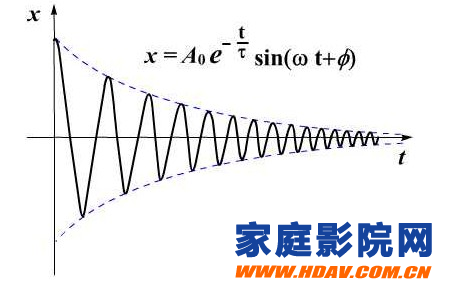[Home theater network hdav.com.cn] We talked about the current caused by impedance, power problem, today, talk about damping.
The concept of damping has been ignored by most players. In fact, this concept is also very important. Let me start with the principle....
How does the horn sound? The current supplied by the amplifier at a certain frequency flows through the voice coil, causing magnetic induction, causing the diaphragm to move forward and backward (from the initial vertical position called displacement), and the displacement pushes the air vibration before and after, producing sound.
However, the diaphragm is of a mass. After being pushed, it has inertia. When the current at this frequency stops, the diaphragm will vibrate back and forth. Imagine that you give the pendulum a force, and he will swing back and forth, leaving the original vertical position.

Let's take a look at this process in time series:
1, A frequency current - push the diaphragm - produce A frequency sound
2. End of A frequency - diaphragm inertia - continuation of A frequency sound, but amplitude is reduced. (pendulum theory, frequency is constant, amplitude is reduced)
3, B frequency current - ??
When the B frequency comes, the diaphragm has not been reset, and the voice coil has generated a new thrust. The latter thing happened: a sound different from the frequencies of A and B was produced. This sound is different from the source signal and is a noise.
The above process is the working state of the horn without the damping, as well as the negative effects. The ideal situation is: when the A frequency ends, the diaphragm is reset, and when the B frequency starts, the diaphragm starts to vibrate from the initial position, which should be the same every time.
At the same time we look at the electromagnetic effect. When in 2 steps, the voice coil performs inertial motion, still cutting the magnetic field, generating induced voltage (have to continue to mention Tesla, electromagnetic induction phenomenon), and the structure of the power amplifier and the horn is simplified, actually it is a resistor. (Looking the power amplifier as an equivalent resistor) in parallel with a horn, the horn generates an induced voltage that forms a current short circuit through the equivalent internal resistance of the parallel power amplifier, creating a resistance that forces it to stop continuing to free. vibration.
Damping = horn impedance / amplifier internal resistance
If the damping is large, the reset is good, and if the damping is small, the distortion is large. However, it must be noted that the human hearing is not a good reset, it is not a small distortion. The damping is high, and the low-frequency sound that is often reset is relatively dry, the damping is low, the low frequency is out of control, the noise is not the same, the turbidity is unclear, and the delay of the delay may cover some intermediate frequencies. The damping value is generally recommended between 50-100, but it is better to judge by your own sense of hearing, and the preferences of people and people are different.
Generally, we choose the amplifier, which will choose high input impedance and low output impedance. Why? Because it is a good match.
Between the signal source and the power amplifier is a voltage driving circuit. When the input impedance is high and the signal source is fixed, the current required is small, which means that it is easy to drive, which means that the chance of being interrupted by current is small, which means that the wire is Reduced current transfer capability requirements!
Between the power amplifier and the horn is a current drive circuit, the output impedance is low, the output is constant, and the current capability is large. As we said before, the horn is driven by the current. This means that in the face of today's low-impedance speakers, the power amplifier's load capacity is strong, which means that the damping capacity is good!
Usb 3.1 Type-C Cable,Usb Cable,Usb Cable Cord,Usb Cable Charger
CHANGZHOU LESEN ELECTRONICS TECHNOLOGY CO.,LTD , https://www.china-lesencable.com
